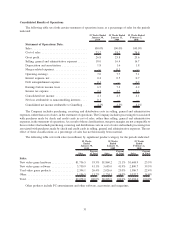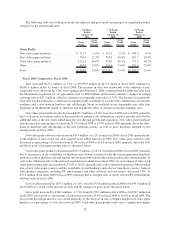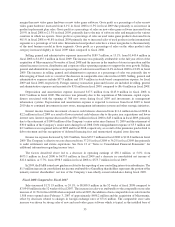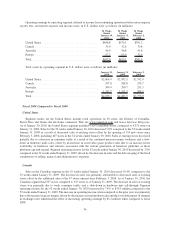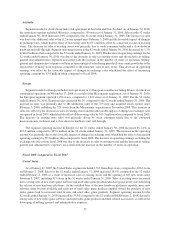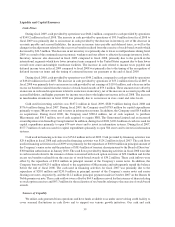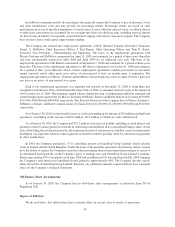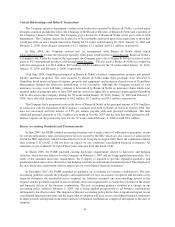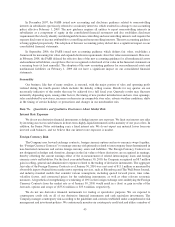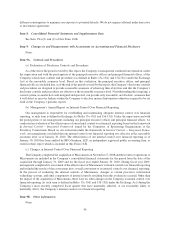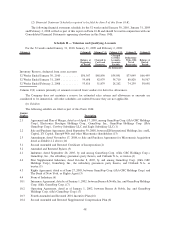GameStop 2009 Annual Report Download - page 55
Download and view the complete annual report
Please find page 55 of the 2009 GameStop annual report below. You can navigate through the pages in the report by either clicking on the pages listed below, or by using the keyword search tool below to find specific information within the annual report.equivalents are carried at cost, which approximates market value, and consist primarily of time deposits with highly
rated commercial banks and money market investment funds holding direct U.S. Treasury obligations.
In October 2005, in connection with the EB merger, the Company entered into a five-year, $400 million Credit
Agreement (the “Revolver”), including a $50 million letter of credit sub-limit, secured by the assets of the Company
and its U.S. subsidiaries. The Revolver places certain restrictions on the Company and its subsidiaries, including
limitations on asset sales, additional liens and the incurrence of additional indebtedness. In April 2007, the
Company amended the Revolver to extend the maturity date from October 11, 2010 to April 25, 2012, reduce the
LIBO interest rate margin, reduce and fix the rate of the unused commitment fee and modify or delete certain other
covenants. The extension of the Revolver to 2012 reduces our exposure to the current tightening in the credit
markets.
The availability under the Revolver is limited to a borrowing base which allows the Company to borrow up to
the lesser of (x) approximately 70% of eligible inventory and (y) 90% of the appraisal value of the inventory, in each
case plus 85% of eligible credit card receivables, net of certain reserves. Letters of credit reduce the amount
available to borrow by their face value. The Company’s ability to pay cash dividends, redeem options, and
repurchase shares is generally prohibited, except that if availability under the Revolver is or will be after any such
payment equal to or greater than 25% of the borrowing base, the Company may repurchase its capital stock and pay
cash dividends. In addition, in the event that credit extensions under the Revolver at any time exceed 80% of the
lesser of the total commitment or the borrowing base, the Company will be subject to a fixed charge coverage ratio
covenant of 1.5:1.0.
The per annum interest rate on the Revolver is variable and, at the Company’s option, is calculated by applying
a margin of (1) 0.0% to 0.25% above the higher of the prime rate of the administrative agent or the federal funds
effective rate plus 0.50% or (2) 1.00% to 1.50% above the LIBO rate. The applicable margin is determined quarterly
as a function of the Company’s consolidated leverage ratio. As of January 30, 2010, the applicable margin was 0.0%
for prime rate loans and 1.00% for LIBO rate loans. In addition, the Company is required to pay a commitment fee
of 0.25% for any unused portion of the total commitment under the Revolver. During the 2009 fiscal year, the
Company borrowed and repaid $115.0 million under the Revolver. As of January 30, 2010, there were no
borrowings outstanding under the Revolver and letters of credit outstanding totaled $8.8 million.
In September 2007, the Company’s Luxembourg subsidiary entered into a discretionary $20.0 million
Uncommitted Line of Credit (the “Line of Credit”) with Bank of America. There is no term associated with
the Line of Credit and Bank of America may withdraw the facility at any time without notice. The Line of Credit
will be made available to the Company’s foreign subsidiaries for use primarily as a bank overdraft facility for short-
term liquidity needs and for the issuance of bank guarantees and letters of credit to support operations. As of
January 30, 2010, there were no cash overdrafts outstanding under the Line of Credit and bank guarantees
outstanding totaled $16.0 million.
In September 2005, the Company, along with GameStop, Inc. as co-issuer (together with the Company, the
“Issuers”), completed the offering of $300 million aggregate principal amount of Senior Floating Rate Notes due
2011 (the “Senior Floating Rate Notes”) and $650 million aggregate principal amount of Senior Notes due 2012
(the “Senior Notes” and, together with the Senior Floating Rate Notes, the “Notes”). The Notes were issued under
an Indenture, dated September 28, 2005 (the “Indenture”), by and among the Issuers, the subsidiary guarantors party
thereto, and Citibank, N.A., as trustee (the “Trustee”). The net proceeds of the offering were used to pay the cash
portion of the merger consideration paid to the stockholders of EB in connection with the EB merger. In November
2006, Wilmington Trust Company was appointed as the new Trustee for the Notes.
The Senior Notes bear interest at 8.0% per annum, mature on October 1, 2012 and were priced at 98.688%,
resulting in a discount at the time of issue of $8.5 million. The discount is being amortized using the effective
interest method. As of January 30, 2010, the unamortized original issue discount was $2.7 million. The Issuers pay
interest on the Senior Notes semi-annually, in arrears, every April 1 and October 1, to holders of record on the
immediately preceding March 15 and September 15, and at maturity.
The Indenture contains affirmative and negative covenants customary for such financings, including, among
other things, limitations on (1) the incurrence of additional debt, (2) restricted payments, (3) liens, (4) sale and
40



